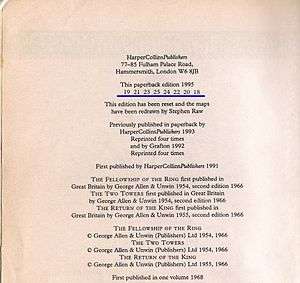Printer's key

The printer’s key, also known as the number line, is a line of text printed on the copyright page (often the verso of the title page, especially in English-language publishing) of books, used to indicate the print run. Publishers began this convention about the middle of the 20th century.
An example follows:
| 1 2 3 4 5 6 7 8 9 10 |
|---|
This is how the printer's key will appear in the first print run of a book. Numbers are removed with subsequent printings, so if "1" is seen then the book is the first printing of that edition. If it is the second printing then the "1" is removed, meaning that the lowest number seen will be "2".
Examples
Usually it is a series of numbers or letters as in the following examples:
| 10 9 8 7 6 5 4 3 2 1 |
|---|
| 1 2 3 4 5 6 7 8 9 10 |
|---|
| a b c d e f g h i j k |
|---|
Sometimes, rather than follow in series, the numbers alternate from left to right for example:
| 2 4 6 8 10 9 7 5 3 1 |
|---|
The purpose of this arrangement is to keep the line of numbers roughly centered even as the numbers are removed with subsequent printings. This format is shown in the copyright page image accompanying this article.
Sometimes number lines also include a date line:
| 2 3 4 5 6 73 72 71 70 |
|---|
This indicates a second printing (or second impression) and that it occurred in 1970. More specifically, it is this particular imprint's second impression of the edition.
Sometimes, when the publisher outsources the printing to a contractor, there is also a code identifying the contracting printer:
| 3 4 5 6 7 8 9 10 APC 00 99 98 97 96 |
|---|
The hypothetical printer’s key above means
- third printing
- printed in 1996
- contracted to Acme Printing Corporation.
First edition vs. first printing
Bibliographers usually define a first edition as all printings from substantially the same type setting, no matter how many printings are done. Book collectors tend to define first edition as the first printing of the first edition. See “Edition (book)”.
Why numbers are removed rather than added
With each successive reprint, the publisher needs to instruct the printer to change the impression number. In practice, if the plates (in offset printing) have been kept, a number can be erased, but nothing can be added. In this arrangement, all the printer must do is "rub off" the last number in sequence. Changing only the outer number requires the fewest possible changes to the page of characters, which means the smallest possible charge to the publisher. In the days of letterpress printing, where each character was a metal block, all the printer had to do was to pick out the relevant blocks from the "sheet"; then the stack of blocks, which had been laboriously laid out when the page was first set up, could be inked for the reprint.[1] In the case of a Linotype slug, the lowest number could be filed off and the slug reused. For offset printing with metal plates, the number can be erased without damaging the rest of the plate. In each case, the change is minimal.